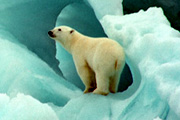Polar Bear Diets
The polar bear is the most carnivorous member of the bear family, feeding mainly on a diet of ice seals.
This is because the polar bear's physiology is specialised to acquire large amounts of fat from marine mammals, the consequence being that it cannot derive sufficient caloric intake from terrestrial food.
Seals are a particularly energy-rich food source, especially for hungry mothers and their growing cubs. In fact polar bears can devour huge amounts of fat (from seals) when this prey is abundant. They are often described as lipophillic (fat loving).
The largest proportion of a polar bear's annual caloric intake occurs between late April and mid-July. Food availability during this period is critical for maintaining their proper body weight to survive the ice-free season, when prey is harder to catch for bears that remain on the sea ice and little or no food is available for bears who remain on shore.
For bears that come ashore in areas such as the Hudson Bay in Canada, this food-free season can last 3 to 4 months or even longer, now that climate change is beginning to take its toll and the ice pack forms later in the season.
What do they eat?
Polar bears feed mainly on ringed and bearded seals.
Depending on where they are located (e.g. Canadian, Norwegian, Russian arctic areas) they may also eat harp, hooded, and the occasional ribbon seal.
Polar bears are also scavengers, and will happily feed on the carcasses of beluga whales, grey whales, walruses, narwhals, and bowhead whales.
Polar bears can also occasionally and successfully hunt beluga whales and adult walrus.
When other food is unavailable, polar bears sometimes eat muskox, reindeer, small rodents, seabirds, shellfish, fish, eggs, kelp, berries, and human garbage (the garbage dump in Churchill, Canada, had to be closed and moved because of this activity).
How much do they eat?
A healthy bear will try to eat on average around 2kg of fat per day. Its stomach can hold food equivalent to 15% to 20% of its own body weight. It can assimilate 84% of the protein and 97% of the fat it eats. A ringed seal weighing 55kg should therefore provide up to 8 days of energy for a polar bear (though it needs to eat more than this in order to store up reserves for the food-free season).
Depending on the age and the condition of the bear, it it will eat different parts of any kill.
Adult bears in good condition prefer the calorie-rich skin and blubber of seals, whereas young bears and adults in poor condition consume the protein-rich red meat as well.
Bears that have left their mother, but have not yet gained full adult size (and are often still learning how to hunt) often scavenge on the carcasses from other bears' kills It is also reported that these subadults may also be forced to accept a half-eaten carcass if they kill a seal but cannot defend it from a larger bear. This is why bears generally eat the fat first - it contains the most calories and is easier to digest.
Polar bears like to keep themselves clean, as it probably helps the insulating properties of their fur. After feeding, they will usually wash themselves with by taking a swim or rolling in the snow.
